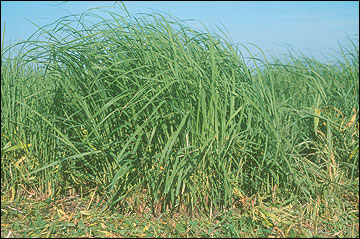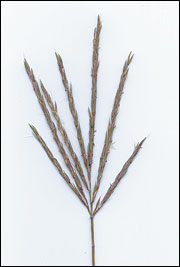Big bluestem (Andropogon gerardii Vitman)
Warm-season grasses
Big bluestem used to be the dominant grass in the native prairies of Missouri. Today, this perennial warm-season bunchgrass is used for forage and wildlife habitat. Big bluestem grows statewide, and it is currently found on about 1 million acres in Missouri. It produces good quality hay and will persist indefinitely if properly managed. It is both winter- and drought-hardy and does better in poorly drained soils than some other warm-season grasses. It is also compatible with many other forage species. However, it is slow to establish, and thus weeds can make establishment a problem. It works well in a planned grazing system if it is not allowed to become mature before grazing and if a 6-inch or greater stubble height is maintained to encourage regrowth.
 Big bluestem
Big bluestem
 Yield distribution of big bluestem in Missouri.
Yield distribution of big bluestem in Missouri.
- Origin: North America
- Adaptation to Missouri: Statewide
- Growth habit: Tall, rhizomatous, perennial bunchgrass.
- Blade: Flat, glabrous on bottom, scabrous on top with rough margins. Base of new shoots flattened, lower portion of blade and sheath pubescent.
- Sheath: Flattened, often shorter than internodes, glaucous, and purplish.
- Ligule: Membranous, sometimes fringed, about 1/10 inch long.
- Auricles: Absent.
- Seed head: Usually 3 (but up to 7), purplish, spike-like racemes per stem.
- Fertilization: 40 to 60 lb N/acre when grass is 3 to 5 inches tall. Phosphorus and potassium to soil test.
- Burning management: Every year or two, when new growth is 1 to 2 inches tall.
- Timing of production: Produces 70 percent of its growth between June 15 and Aug. 31.
- When to begin grazing: When grass is 12 inches tall.
- When to cut for hay: Boot stage
- Lowest cutting or grazing height: 6 inches
- Fall management: Do not hay or graze after Sept. 1.

